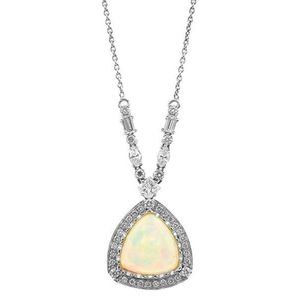Opal and Diamond Pendant Necklace in 18ct White Gold
You must be a subscriber, and be logged in to view price and dealer details.
Subscribe Now to view actual auction price for this item
When you subscribe, you have the option of setting the currency in which to display prices to $Au, $US, $NZ or Stg.
- Emeralds - Emeralds have been used in jewellery making for thousands of years, and are prized for their deep green colour, which is caused by the presence of chromium and vanadium in the mineral beryl. Because of their rare colour, emeralds are often more valuable than diamonds of a similar size and quality. In jewellery making, emeralds are typically cut into round or oval shapes to maximize their color and clarity. They are often set in gold or platinum and used as the centrepiece of a piece of jewellery, such as a ring or necklace. They can also be used in combination with other gems, such as diamonds, to create intricate and beautiful designs.
- Cabochon Cut in Jewellery - A cabochon cut is a type of gemstone cutting where the stone is cut and polished in a convex shape with a flat bottom and a domed top, with no facets. This type of cut is typically used for opaque or translucent stones that have natural patterns or inclusions that are best displayed in this type of cut. Examples of stones that are often cut as cabochons include turquoise, opal, and moonstone.
- Brilliant Cut - In their naturally occuring state diamonds have little life or sparkle and for many centuries were simply cut in half and worn in amulets. Invented at the end of the 17th century by a Venetian diamond cutter, a "brilliant cut" diamond has 58 facets arranged in a regular geometric relationship, with 33 above the crown and 25 below on the pavilion.
The introduction of the brilliant cut increased the popularity of diamonds in jewellery as it was the first cut to reveal the fire of the diamond, with the light being internally reflected from one facet to another, and was superior to the previously used table cut and rose cut.Variants to the brilliant cut have emerged since the end of the 17th century, but the popularity of the original brilliant cut has continued to the present time, where it is still the most commonly found cut.
.
This item has been included into following indexes:
Visually similar items

An antique portrait pendant on chain, comprising a double sided porcelain painted pendant featuring a mother and child to verso, with seed pearl and diamond decoration, mounted in 15ct gold

A silver salver, Denis Wilks, London 1737, of circular scalloped and foliate form with central crest, supported on scrolling feet, 14 cm diameter, 584gms

A diamond pendant necklace, centrally set with a marquise cut diamond of 1.00cts, surrounded by white diamonds totalling 0.53cts, to a fine trace chain, all mounted in 18ct white gold

An emerald and yellow diamond pendant, featuring an oval emerald cut en cabochon, weighing 16.68cts within a diamond set surround and yellow diamond surmount, totalling 2.77cts, in two tone 18ct gold
